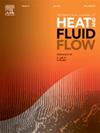Experimental study of the flow pattern and heat transfer characteristics of the refrigerant flow condensation through metal foam inserts
IF 2.6
3区 工程技术
Q2 ENGINEERING, MECHANICAL
International Journal of Heat and Fluid Flow
Pub Date : 2025-03-11
DOI:10.1016/j.ijheatfluidflow.2025.109801
引用次数: 0
Abstract
Metal foams have shown remarkable effects on heat transfer improvement in diabatic two-phase flows, especially for refrigeration applications. The present experimental study addresses the flow condensation regimes and characteristics of R134a in 10 PPI and 20 PPI copper foam inserts inside 8 mm i.d. tubes. The flow pattern maps were extracted under uniform wall temperature boundary conditions for mass flux 75–150 kg m−2 s−1. In this study, three distinct flow regimes are introduced in the presence of metal foams: stratified–wavy, wavy–annular, and annular. Although the outcomes prove that the PPI of metal foam is a determining factor for the distribution of flow patterns on the map, the stratified–wavy regime is majorly captured at low-quality and low-mass flux zones, while the annular pattern is only observable at high-quality and high-mass flux zone of the maps. The flow maps revealed that the annular to wavy–annular regime transition withdraws from a vapor quality of 0.6 to approximately 0.3 at the highest mass flux. Similarly, the wavy–annular to stratified–wavy pattern transition falls back from a quality of 0.7 to around 0.35 at the mass flux of 100 kg m−2 s−1. In addition, this research investigates how vapor quality, mass flux, and foam pore density affect heat transfer and pressure losses during condensation. An intensive correlation between heat transfer coefficient and flow variables of mass flux and vapor quality is noted. 20 PPI foam owns larger heat transfer coefficients than 10 PPI, while the pressure drop within the 20 PPI insert is significantly larger than in 10 PPI. The metal foam inserts helped enhance the heat transfer coefficient by about 220 %. The findings show that the pressure drop progressively elevates as the quality of vapor and mass flux rise. The use of copper foam inserts of 20 PPI, particularly at high vapor qualities, is beneficial in applications where heat transfer enhancement is a priority.
求助全文
约1分钟内获得全文
求助全文
来源期刊

International Journal of Heat and Fluid Flow
工程技术-工程:机械
CiteScore
5.00
自引率
7.70%
发文量
131
审稿时长
33 days
期刊介绍:
The International Journal of Heat and Fluid Flow welcomes high-quality original contributions on experimental, computational, and physical aspects of convective heat transfer and fluid dynamics relevant to engineering or the environment, including multiphase and microscale flows.
Papers reporting the application of these disciplines to design and development, with emphasis on new technological fields, are also welcomed. Some of these new fields include microscale electronic and mechanical systems; medical and biological systems; and thermal and flow control in both the internal and external environment.
 求助内容:
求助内容: 应助结果提醒方式:
应助结果提醒方式:


